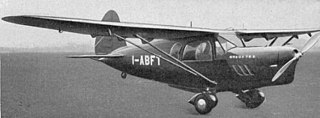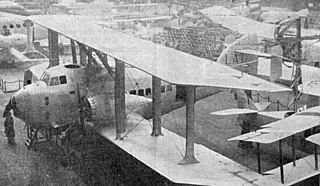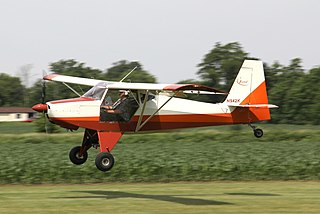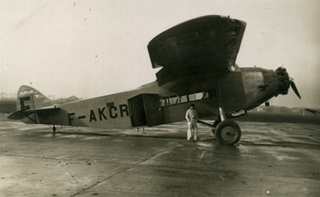Related Research Articles

The Breda Ba.79S was a single-engine four-seat high-wing private aircraft built in Italy in the late 1930s. Only a few were produced.

The Latécoère 4 was a three-engined, 15-passenger biplane built in France in the early 1920s. It proved difficult to fly and was discontinued, though a second machine was completed as the Latécoère 5 bomber.

The Latécoère 350 was a trimotor development of the Latécoère 28, a successful single-engined French monoplane of around 1930. The three engines were intended to provide the reliability needed for overnight flights, but the 350 came out very overweight. Only one was built.
The Latécoère 550 was a four-engined French seaplane, designed in the early 1930s as a bomber/torpedo bomber. Though initial handling problems were partly resolved, the aircraft was deemed too slow and did not go into production.

The Just Escapade is a single-engine, high-wing light aircraft, seating two in side-by-side configuration. It was jointly developed in the United States and the United Kingdom in the early 2000s and by 2010 some 145 Escapades and its "bush plane" variant, the Highlander, had been built and many more kits sold.
The Escapade Kid is a single-engine, single-seat, high-wing monoplane, developed and built in the United Kingdom in the 2000s.
The Wendt W-2 Swift was a two-seat, single-engine, braced high-wing monoplane built in the United States just before World War II. Only one was built.
The SABCA S.11 or SABCA S.XI was a prototype Belgian airliner of the 1930s. It was a three-engined high-winged monoplane intended for service in the Belgian Congo, but only a single example was built.
The MMPL Kanpur was an Indian light four-seat aircraft, designed for service and agricultural work in the early 1960s. It is a rare example of an aircraft designed and built by a national air force for its own use.
The Bloch MB.90 was the first all-metal French light aircraft. Only two aircraft were completed, making their first flights in 1932, though there were several variants.

The Villiers 31 or Villiers 310 was a French eight passenger airliner of advanced construction. Owing to Villiers' financial failure, it was not developed.

The Caproni Ca.95 was a large, three engine, long range, heavy bomber prototype built in Italy in 1929. It could carry a 1,600 kg (3,500 lb) bomb load and had three defensive gun positions. Only one was built.
The Romano R.16 was a three engine, high wing monoplane designed for policing and other rôles in France's African colonies.
The Kellner-Béchereau 23 was a French two seat cabin touring aircraft, built in 1932. Its wing was constructed in a novel way. Only one was completed.

The Hanriot H.25 was a French, single-engined, six passenger airliner built in 1926. Only one was flown.

The G.A.C. 102 Aristocrat or General 102 Aristocrat is a single-engined cabin monoplane built in the US just before the Great Depression. It proved popular, with over forty built; an early example was taken on an aerial survey of Antarctica. One survives.
The Gabriel Śląsk (Silesia) was a Polish light aircraft designed and built by an amateur in the mid-1930s. After two flights the Polish authorities banned further development.

The Wallace Touroplane was a late 1920s U.S. three seat, high wing cabin monoplane. About 20 were built.

The Huntington H-11 Governor was a two-seat cabin monoplane with a high, cantilever wing built in the United States and first flown around 1930. Three were completed.

The Lincoln AP was a U.S., single engine, high wing, general purpose civil cabin aircraft first flown in 1930. Only four were built.
References
- 1 2 3 4 Charles Mali. "Le Sabca S 12" (PDF). Retrieved 30 November 2016.
- 1 2 3 James, Derek (1991). Westland Aircraft since 1915. London: Putnam Publishing. pp. 180–1. ISBN 0-85177-847-X.
- ↑ "Renard R-30". Fonds National Alfred Renard. Retrieved 1 December 2016.
- 1 2 3 4 5 6 7 8 Frachet, André (12 November 1931). "L'avion commercial léger S. A. B. C. A. XII". Les Ailes (543): 3.
- 1 2 3 4 5 6 "The S.A.B.C.A S.XII". Flight . XXIII (51): 1237. 18 December 1931.